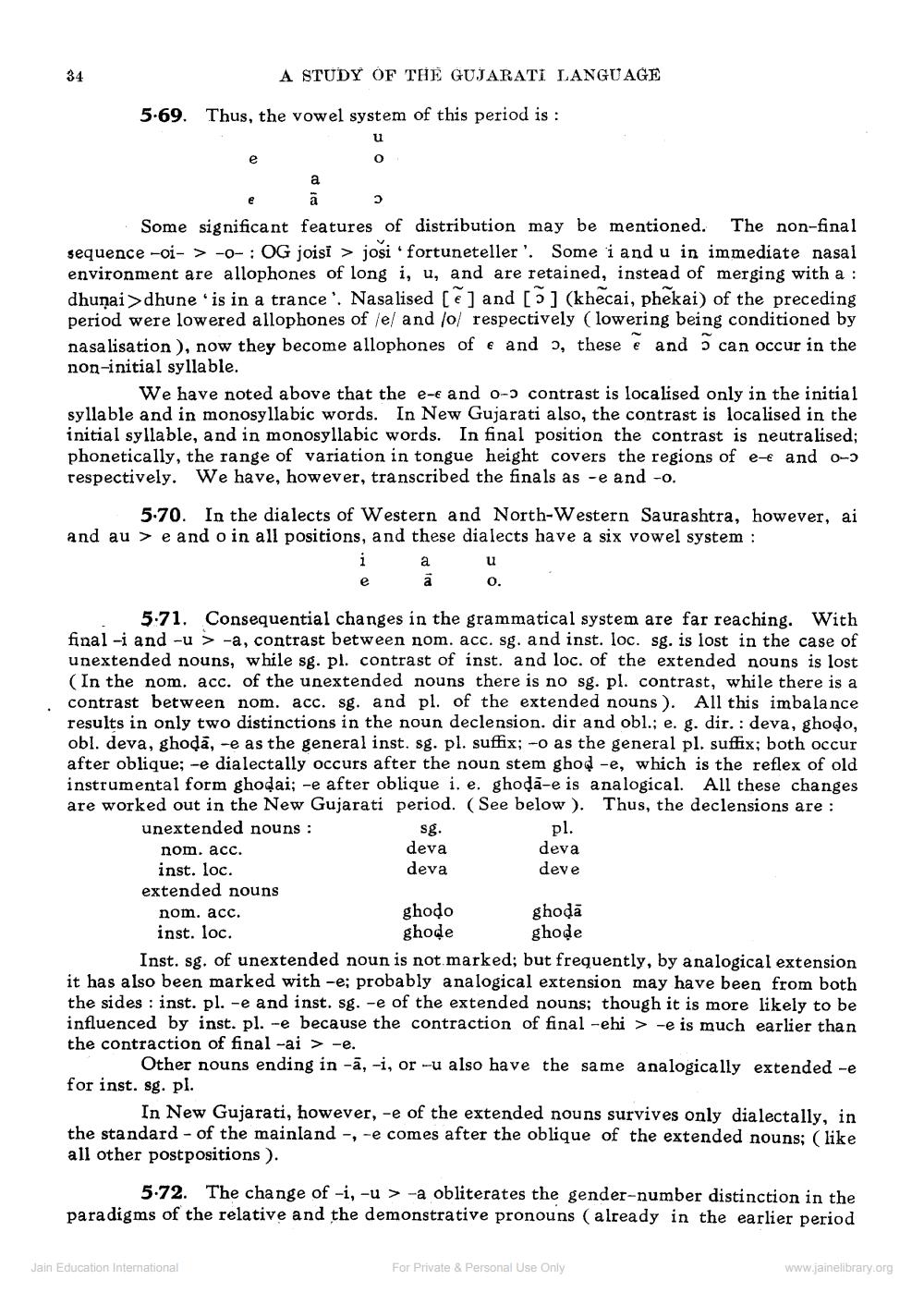________________
A STUDY OF THE GUJARATI LANGUAGE
5.69. Thus, the vowel system of this period is :
а
108
Some significant features of distribution may be mentioned. The non-final sequence -oi- >-0-: OG joisi > josi' fortuneteller'. Some i and u in immediate nasal environment are allophones of long i, u, and are retained, instead of merging with a : dhunai>dhune is in a trance'. Nasalised [?] and [] (khecai, phekai) of the preceding period were lowered allophones of /e/ and /o/ respectively (lowering being conditioned by nasa lisation ), now they become allophones of e and ɔ, these 2 and 3 can occur in the non-initial syllable.
We have noted above that the e-€ and 0-) contrast is localised only in the initial syllable and in monosyllabic words. In New Gujarati also, the contrast is localised in the initial syllable, and in monosyllabic words. In final position the contrast is neutralised; phonetically, the range of variation in tongue height covers the regions of e-€ and 0-3 respectively. We have, however, transcribed the finals as -e and -o.
5.70. In the dialects of Western and North-Western Saurashtra, however, ai and au > eand o in all positions, and these dialects have a six vowel system :
i au e a
0.
5.71. Consequential changes in the grammatical system are far reaching. With final -i and -u > -a, contrast between nom. acc. sg. and inst. loc. sg. is lost in the case of unextended nouns, while sg. pl. contrast of inst. and loc. of the extended nouns is lost (In the nom. acc. of the unextended nouns there is no sg. pl. contrast, while there is a contrast between nom. acc. sg. and pl. of the extended nouns). All this imbalance results in only two distinctions in the noun declension. dir and obl.; e. g. dir. : deva, ghodo, obl. deva, ghoda, -e as the general inst. sg. pl. suffix; -o as the general pl. suffix; both occur after oblique; -e dialectally occurs after the noun stem ghod -e, which is the reflex of old instrumental form ghodai; -e after oblique i. e. ghoda-e is analogical. All these changes are worked out in the New Gujarati period. (See below). Thus, the declensions are : unextended nouns :
sg.
pl. nom. acc.
deva
deva inst. loc.
deva
deve extended nouns nom. acc.
ghodo
ghodā inst. loc.
ghode ghode Inst. sg. of unextended noun is not marked; but frequently, by analogical extension it has also been marked with -e; probably analogical extension may have been from both the sides : inst. pl. -e and inst. sg. -e of the extended nouns; though it is more likely to be influenced by inst. pl. -e because the contraction of final -ehi > -e is much earlier than the contraction of final -ai > -e.
Other nouns ending in -a, -i, or -u also have the same analogically extended -e for inst. sg. pl.
In New Gujarati, however, -e of the extended nouns survives only dialectally, in the standard - of the mainland -, -e comes after the oblique of the extended nouns; (like all other postpositions ).
5.72. The change of -i, -u > -a obliterates the gender-number distinction in the paradigms of the relative and the demonstrative pronouns (already in the earlier period
Jain Education International
For Private & Personal Use Only
www.jainelibrary.org




